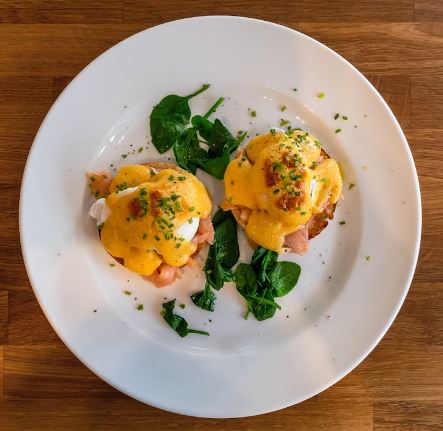Research consistently demonstrates that using smaller plates can lead to a reduction in calorie intake. When you downsize your plate, you automatically reduce the amount of food you serve yourself…reports Asian Lite News
The choice of plate size can have an impact on your meal intake and weight loss efforts. Dr Rohini Patil, MBBS and Certified Nutritionist shares some pointers highlighting the difference it makes as big vs small plates with the benefits of small plate meals:
Perception of Portion Size:
When you use a smaller plate, the same amount of food occupies a larger portion of the plate’s surface area. This creates a visual illusion that the portion is larger than it is. Your brain interprets this as a more substantial meal, leading to feelings of satisfaction and fullness. By perceiving your meal as larger, you’re less likely to feel deprived and are more likely to be satisfied with a smaller amount of food, ultimately supporting your weight loss efforts.

Controlled Portion Sizes:
Using a smaller plate naturally limits the amount of food you can serve yourself. The physical constraint of a smaller plate acts as a built-in portion control tool. It visually indicates how much food you should consume, making it easier to moderate your intake. This helps you create a calorie deficit necessary for weight loss, as you’re more mindful of the portion sizes and less likely to overindulge.
Mindful Eating:
When you choose a smaller plate, you’re encouraged to eat more mindfully. With a smaller portion in front of you, you’re likely to slow down and pay closer attention to each bite. This allows you to savour your food’s flavours, textures, and aromas. Mindful eating helps you tune into your body’s hunger and fullness cues, promoting a greater sense of satisfaction. By being present and attentive while eating, you’re less likely to overeat and more likely to make healthier choices.
Calorie Reduction:
Research consistently demonstrates that using smaller plates can lead to a reduction in calorie intake. When you downsize your plate, you automatically reduce the amount of food you serve yourself. This reduction in portion size directly translates into a decrease in calorie consumption. Over time, this calorie reduction can contribute to weight loss or weight maintenance, as you consistently consume fewer calories than you would with larger plates.
Psychological Satisfaction:
Despite the smaller portion size, using a smaller plate can still provide psychological satisfaction. The visual perception of a full plate, even with a reduced amount of food, can trick your brain into feeling satisfied. This helps overcome the psychological aspect of feeling deprived when reducing portion sizes. The satisfaction derived from seeing a full plate can contribute to a positive mindset and help you adhere to your weight loss goals without sacrificing enjoyment.

Sustainable Eating Habits:
Incorporating smaller plates into your eating habits promotes long-term behaviour changes. By consistently using smaller plates, you train your brain to recognise appropriate portion sizes. This re-education process helps reshape your relationship with food, making it easier to maintain a healthy weight. Smaller plates encourage portion control and discourage overeating, leading to sustainable and healthier eating habits.
Environment and Plate Size:
The size of your plate influences your perception and consumption not only through visual cues but also by affecting the overall environment. When you use smaller plates, you’re more likely to arrange your food in a visually appealing way, creating a fuller-looking plate. This arrangement can enhance the sensory experience of your meal and contribute to a greater feeling of satisfaction.
Social Influence:
Using smaller plates can positively influence others around you. When you serve meals on smaller plates during social gatherings, it normalises portion control and promotes healthier eating habits. It encourages everyone to be more mindful of their portions and can support a collective effort toward weight management and overall well-being.
Plate Colour and Contrast:
Along with plate size, the colour and contrast of your plate can also influence your eating behaviour. Research suggests that using plates with high colour contrast to the food, such as white plates with colourful vegetables, can enhance portion perception and increase the satisfaction derived from the meal.
Visual Representation of Progress:
Using a smaller plate can serve as a visual representation of your progress toward healthier eating habits and weight loss. As you transition from larger plates to smaller ones, you can physically see the reduction in portion sizes. This visual reminder reinforces your commitment to portion control and encourages you to continue making mindful choices, ultimately supporting your weight loss journey.
Increased Awareness of Satiation Point:
By using a smaller plate, you become more attuned to your body’s satiation point. As you consume your meal, you pay closer attention to your feelings of fullness and satisfaction. This heightened awareness allows you to stop eating when you genuinely feel satisfied, rather than mindlessly finishing everything on your plate. Recognising your satiation point promotes self-regulation of food intake and prevents unnecessary overeating.
Enhanced Nutrient Density:
Smaller plates encourage you to focus on nutrient-dense foods. With limited space on the plate, you prioritise filling it with nutrient-rich options such as vegetables, lean proteins, and whole grains. By choosing these foods and reducing the portion sizes of calorie-dense options, you optimize the nutritional quality of your meals. This shift toward a nutrient-dense plate supports your overall health and weight management goals.
Portion Size Consistency:
Using smaller plates promotes consistency in portion sizes. When you consistently serve your meals on smaller plates, it becomes a habitual practice. This helps train your brain to recognise appropriate portion sizes, even when you’re not using a smaller plate. You develop a better sense of portion control and are more likely to make balanced choices when eating from different-sized plates or in social settings.

Improved Digestion and Satisfaction:
Opting for a smaller plate can have a positive impact on digestion and overall satisfaction after a meal. When you consume a smaller portion, your body can digest the food more efficiently. This can result in a greater sense of comfort and reduced bloating. Additionally, feeling satisfied with a smaller portion supports positive psychological well-being and can help you maintain a consistent and sustainable approach to your weight loss journey.
Remember, plate size is just one factor in managing your weight. It’s essential to focus on the overall quality of your diet, including nutrient-dense foods, regular physical activity, and a balanced lifestyle to achieve sustainable weight loss and overall well-being.
ALSO READ-Delectable prawn recipes to satisfy seafood cravings














